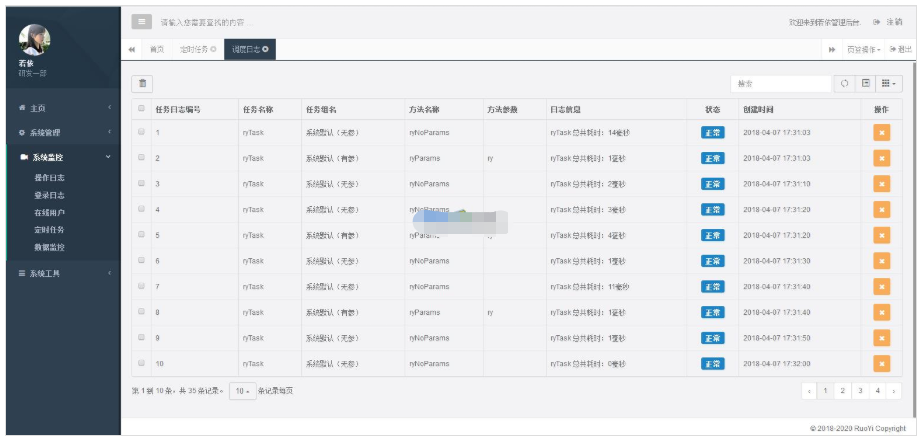在 go 协程中同步不同时区的方法:使用 time.loadlocation() 函数从时区数据库中加载时区信息,返回代表该时区的 *time.location 实例。在协程中使用上下文,将 *time.location 上下文传递给每个协程,使其可以访问相同的时间信息。在实际应用中,可以根据订单的时区打印时间戳或处理订单的逻辑。

如何在 Goroutine 中同步不同的时区
协程是一个轻量级的线程,经常在 Go 中用于并发编程。当在不同时区处理数据时,手动同步时间可能会很棘手。本教程将展示如何使用 Go 标准库来处理不同的时区并保持时间同步。
使用 time.LoadLocation()
立即学习“go语言免费学习笔记(深入)”;
time.LoadLocation() 函数用于从时区数据库中加载时区信息。通过提供时区的名称,可以获取一个代表该时区的 *time.Location 实例。

一直想做一款后台管理系统,看了很多优秀的开源项目但是发现没有合适自己的。于是利用空闲休息时间开始自己写一套后台系统。如此有了若依管理系统。她可以用于所有的Web应用程序,如网站管理后台,网站会员中心,CMS,CRM,OA。所有前端后台代码封装过后十分精简易上手,出错效率低。同时支持移动客户端访问。系统会陆续更新一些实用功能。 您是否在找一套合适后台管理系统。 您是否在找一套代码易读易懂后台
 885
885

import (
"fmt"
"time"
)
func main() {
// 加载东京时区
tokyo, err := time.LoadLocation("Asia/Tokyo")
if err != nil {
log.Fatal(err)
}
// 加载纽约时区
newYork, err := time.LoadLocation("America/New_York")
if err != nil {
log.Fatal(err)
}
// 创建一个 Tokyo 时间的时刻
tokyoTime := time.Now().In(tokyo)
fmt.Println("东京时间:", tokyoTime.Format("2006-01-02 15:04:05"))
// 创建一个纽约时间的一个时刻
newYorkTime := time.Now().In(newYork)
fmt.Println("纽约时间:", newYorkTime.Format("2006-01-02 15:04:05"))
}在协程中使用上下文
当使用协程处理数据时,可以在将 *time.Location 上下文传递到每个协程中,这样它们都可以访问相同的时间信息。
package main
import (
"context"
"fmt"
"time"
)
func main() {
ctx := context.Background()
// 加载东京时区
tokyo, err := time.LoadLocation("Asia/Tokyo")
if err != nil {
log.Fatal(err)
}
// 使用 Tokyo 时区创建上下文
ctx = context.WithValue(ctx, "timeZone", tokyo)
go func() {
// 从上下文中获取时区
timeZone := ctx.Value("timeZone").(*time.Location)
// 创建东京时间的一个时刻
tokyoTime := time.Now().In(timeZone)
fmt.Println("东京时间:", tokyoTime.Format("2006-01-02 15:04:05"))
}()
// 加载纽约时区
newYork, err := time.LoadLocation("America/New_York")
if err != nil {
log.Fatal(err)
}
// 使用纽约时区创建上下文
ctx = context.WithValue(ctx, "timeZone", newYork)
go func() {
// 从上下文中获取时区
timeZone := ctx.Value("timeZone").(*time.Location)
// 创建纽约时间的一个时刻
newYorkTime := time.Now().In(timeZone)
fmt.Println("纽约时间:", newYorkTime.Format("2006-01-02 15:04:05"))
}()
time.Sleep(time.Second)
}实战
让我们看一个实际的例子,在该例子中,我们将使用不同的时区处理来自不同地区的订单。
package main
import (
"context"
"fmt"
"time"
)
type Order struct {
Timestamp time.Time
Location string
}
func main() {
ctx := context.Background()
// 加载东京时区的订单
tokyoOrder := Order{
Timestamp: time.Now().In(time.LoadLocation("Asia/Tokyo")),
Location: "Tokyo",
}
// 加载纽约时区的订单
newYorkOrder := Order{
Timestamp: time.Now().In(time.LoadLocation("America/New_York")),
Location: "New York",
}
// 使用东京时区创建上下文
ctxTokyo := context.WithValue(ctx, "order", tokyoOrder)
// 使用纽约时区创建上下文
ctxNewYork := context.WithValue(ctx, "order", newYorkOrder)
go processOrder(ctxTokyo)
go processOrder(ctxNewYork)
time.Sleep(time.Second)
}
func processOrder(ctx context.Context) {
// 从上下文中获取订单
order := ctx.Value("order").(Order)
// 根据订单的时区打印时间戳
fmt.Printf("订单来自 %s,时间戳为:%s\n", order.Location, order.Timestamp.Format("2006-01-02 15:04:05"))
}以上就是如何用 Golang 在不同时区的协程中同步时间?的详细内容,更多请关注php中文网其它相关文章!

每个人都需要一台速度更快、更稳定的 PC。随着时间的推移,垃圾文件、旧注册表数据和不必要的后台进程会占用资源并降低性能。幸运的是,许多工具可以让 Windows 保持平稳运行。

Copyright 2014-2025 https://www.php.cn/ All Rights Reserved | php.cn | 湘ICP备2023035733号